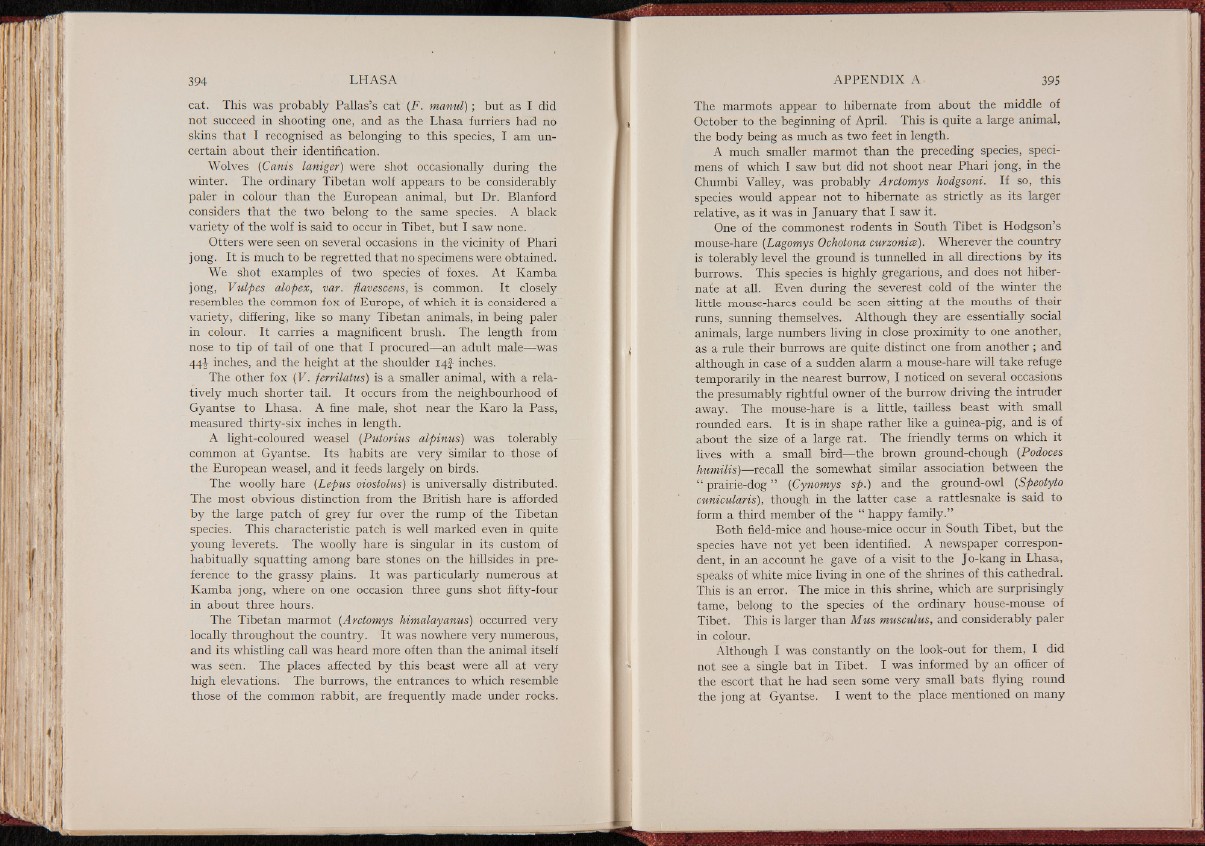
cat. This was probably Pallas’s cat (F . manul); but as I did
not succeed in shooting one, and as the Lhasa furriers had no
skins that I recognised as belonging to this species, I am uncertain
about their identification.
Wolves (Canis laniger) were shot occasionally during the
winter. The ordinary Tibetan wolf appears to be considerably
paler in colour than the European animal, but Dr. Blanford
considers that the two belong to the same species. A black
variety of the wolf is said to occur in Tibet, but I saw none.
Otters were seen on several occasions in the vicinity of Phari
jong. It is much to be regretted that no specimens were obtained.
We shot examples of two species of foxes. At Kamba
jong, Vulpes alopex, var. flavescens, is common. It closely
resembles the common fox of Europe, of which it is considered a
variety, differing, like so many Tibetan animals, in being paler
in colour. It carries a magnificent brush. The length from
nose to tip of tail of one that I procured— an adult male— was
44^ inches, and the height at the shoulder 14I- inches.
The other fox (V. ferrilatus) is a smaller animal, with a relatively
much shorter tail. It occurs from the neighbourhood of
Gyantse to Lhasa. A fine male, shot near the Karo la Pass,
measured thirty-six inches in length.
A light-coloured weasel (Putorius alpinus) was tolerably
common at Gyantse. Its habits are very similar to those of
the European weasel, and it feeds largely on birds.
The woolly hare (Lepus oiosiolus) is universally distributed.
The most obvious distinction from the British hare is afforded
by the large patch of grey fur over the rump of the Tibetan
species. This characteristic patch is well marked even in quite
young leverets. The woolly hare is singular in its custom of
habitually squatting among bare stones on the hillsides in preference
to the grassy plains. It was particularly numerous at
Kamba jong, where on one occasion three guns shot fifty-four
in about three hours.
The Tibetan marmot (Arctomys himalayanus) occurred very
locally throughout the country. It was nowhere very numerous,
and its whistling call was heard more often than the animal itself
was seen. The places affected by this beast were all at very
high elevations. The burrows, the entrances to which resemble
those of the common rabbit, are frequently made under rocks.
The marmots appear to hibernate from about the middle of
October to the beginning of April. This is quite a large animal,
the body being as much as two feet in length.
A much smaller marmot than the preceding species, specimens
of which I saw but did not shoot near Phari jong, in the
Chumbi Valley, was probably Arctomys hodgsoni. If so, this
species would appear not to hibernate as strictly as its larger
relative, as it was in January that I saw it.
One of the commonest rodents in South Tibet is Hodgson’s
mouse-hare (Lagomys Ochotona curzonicc). Wherever the country
is tolerably level the ground is tunnelled in all directions by its
burrows. This species is highly gregarious, and does not hiber-
nafe at all. Even during the severest cold of the winter the
little mouse-hares could be seen sitting at the mouths of their
runs, sunning themselves. Although they are essentially social
animals, large numbers living in close proximity to one another,
as a rule their burrows are quite distinct one from another ; and
although in case of a sudden alarm a mouse-hare will take refuge
temporarily in the nearest burrow, I noticed on several occasions
the presumably rightful owner of the burrow driving the intruder
away. The mouse-hare is a little, tailless beast with small
rounded ears. It is in shape rather like a guinea-pig, and is of
about the size of a large rat. The friendly terms on which it
lives with a small bird— the brown ground-chough (Podoces
humilis)— recall the somewhat similar association between the
“ prairie-dog ” (Cynomys sp.) and the ground-owl (Speotyto
cunicularis), though in the latter case a rattlesnake is said to
form a third member of the “ happy family.”
Both field-mice and house-mice occur in South Tibet, but the
species have not yet been identified. A newspaper correspondent,
in an account he gave of a visit to the Jo-kang in Lhasa,
speaks of white mice living in one of the shrines of this cathedral.
This is an error. The mice in this shrine, which are surprisingly
t a m p , belong to the species of the ordinary house-mouse of
Tibet. This is larger than Mus musculus, and considerably paler
in colour.
Although I whs constantly on the look-out for them, I did
not see a single bat in Tibet. I was informed by an officer of
the escort that he had seen some very small bats flying roimd
the jong at Gyantse. I went to the place mentioned on many